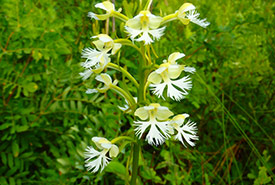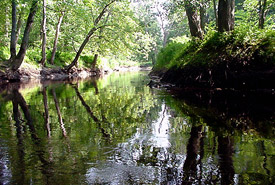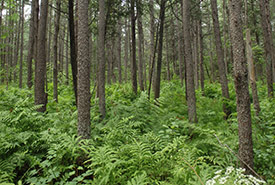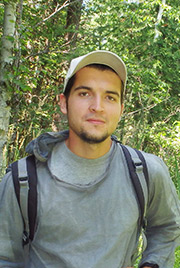Hunting orchids in Minesing wetland

Eastern prairie white-fringed orchid (Photo by NCC)
As an intern with the Nature Conservancy of Canada (NCC), I often find myself walking a fine line between work and play. Even the toughest days are balanced by the realization that my workplace typically consists of wetlands, grasslands and forests. A couple of interesting days in the Minesing Wetlands this past July represent the perfect example of this ongoing “struggle” (and I use that word lightly).
This is a short “day in the life of” story for anyone out there interested in pursuing conservation science as a career path, in the hopes that it will keep you motivated.
My supervisor, Kristyn Ferguson, informed me one day of some upcoming field work in the Minesing Wetlands. Work in Minesing is certainly nothing new but the goal of this particular adventure was to locate and map endangered orchids in the heart of the wetland complex!

Willow Creek, Minesing Wetlands, ON (Photo by Nottawasaga Valley Conservation Authority)
To provide a bit of background, I grew up in Barrie, about 10 minutes east of the wetlands. I accidentally discovered the beauty of Minesing a few years ago while searching for a close location for a spring canoe adventure. I’ve since been fascinated with the jaw-dropping beauty of the place and I’m always happy to find an excuse to return.
The first morning of our two-day orchid hunting trek started like most other days in the field. I met with the rest of the team, which included Kristyn and myself from NCC, Jessica Poole from the Ontario Federation of Anglers and Hunters and Dave Featherstone from the Nottawasaga Valley Conservation Authority.
We took our time to gear up and check our maps. We hiked on a small trail into a beautiful patch of woodlands and quickly began our downhill descent.
Once you reach the swamp forest that borders Minesing, you quickly realize why they call it a wetland: ground turns to mud; mud turns to puddles; puddles turn to pools; and pools quickly turn into hidden ponds disguised as root hummocks and dense vegetation. At this point, the struggle is real! Tripping and falling was inevitable and each of us had our own soaker at least once.
Walking last in line became a luxury, both for seeing the safe footsteps made by those ahead and for avoiding the embarrassment of the occasional stumble. We took the odd short break to catch our breath and get our directional bearings, but not long enough to let the clouds of Minesing mosquitoes carry us away.
Our hike consisted of roughly a kilometre of this intense hiking until the dense swamp forest slowly started to thin out and new, interesting life began to emerge.

Tamarack forest (Photo by NCC)
As the forest thinned, we approached the fen ecosystem in the complex that we'd aimed to monitor that day. Fens are groundwater-fed wetlands that host a variety of interesting plant species. While walking on a fen, you are essentially held up by a dense floating mat of slowly decaying vegetation. One jump sends a ripple through the mat in all directions, like a hard trampoline. It’s a lot of fun until the first time your leg plunges through a hole in the mat, giving you a quick wake-up call of what you’re actually standing on!
Upon entering the fen, we were first greeted by an array of pitcher plants, buckbean, stunted tamaracks and a variety of orchid species. The last of these was on the mind of everyone in the group. In particular, we were curious whether we'd find a certain species — the eastern prairie white-fringed orchid (EPWO).
Populations of this endangered species are few and far between, since their ideal wetland habitat is in decline. Minesing is somewhat of an EPWO stronghold in Ontario, which is why there is a need to monitor the population to ensure its health and longevity.
At the sight of the open fen, my competitive side began to kick in. I had to be the first to find one!
We spread out in a line and began a northward march across the thin band of open wetland, searching for signs of our elusive orchid. Dave was the first to spot one. Then another. And another. It was clear we were in EPWO territory now and we were all on high alert.
It wasn’t long before we had each spotted a handful and could relax a bit. I decided that I had to take some pictures, as the orchids are a real sight to see. In my mind, each individual flower resembles a little person with long fingers and toes. Orchid flowers always have such interesting shapes and resemblances!
The trip was a success, having documented approximately 60 individual orchids over the two days and gaining the experience of a lifetime. Though I’ve tried, it’s hard putting the experience into words. If you’ve never had the opportunity to explore a large intact wetland like Minesing, it is well worth it. Be prepared for bugs, tired legs and directional disorientation; but also for the opportunity to experience the quiet beauty of unique untouched ecosystems and the beautiful and rare life that they hold.


